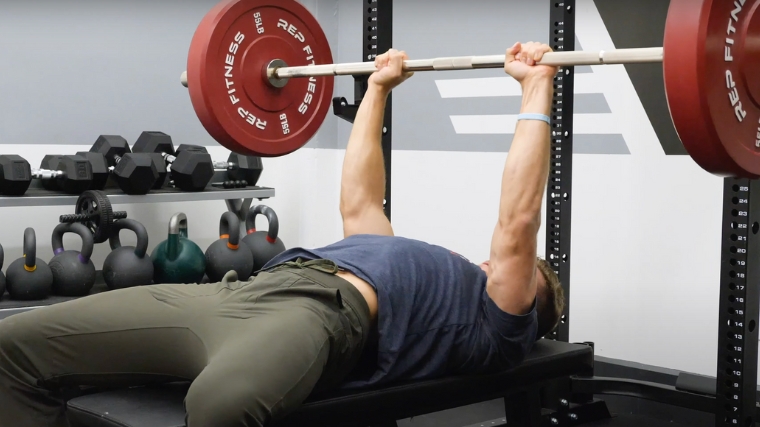If you’ve got a burning passion for the bench press, well, good. After all, it’s one of the best barbell exercises you can do. For the powerlifter, benching is an entire third of their sport. For the average gym bro or aspiring bodybuilder, it’s a pec growing machine. What’s not to love?
However, there’s a chance you’ve not been bitten by the bench bug yet. If you just don’t jam with the movement, that’s fine — but you also could simply be using the wrong grip. Adjusting your hand placement might just be the key to finally getting along with your bench press.
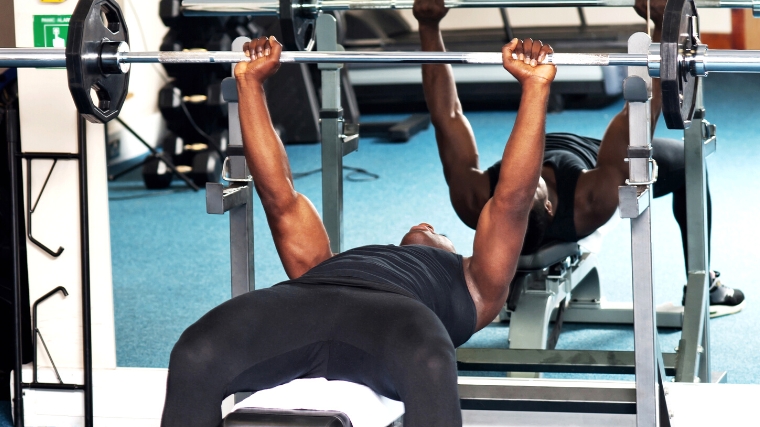
Here are seven different options to try, plus a refresher on how to bench press like a pro.
Best Bench Press Grips
Editor’s Note: The content on BarBend is meant to be informative in nature, but it should not be taken as medical advice. When starting a new training regimen and/or diet, it is always a good idea to consult with a trusted medical professional. We are not a medical resource. The opinions and articles on this site are not intended for use as diagnosis, prevention, and/or treatment of health problems. They are not substitutes for consulting a qualified medical professional.
Standard Grip
There’s no “standardized” grip width for the bench press. That said, several different grip styles use descriptors like “close” or “wide”, so it helps to have a point of reference for that kind of nomenclature.
Your standard-width bench press grip should serve as a nice middle ground. Most athletes and gymgoers will typically grab the barbell at one-and-a-half-times the width of their shoulders. Often, this will align with putting your middle or ring finger over the mark in the knurling.
Benefits of the Standard Grip
- Should be reasonably comfortable for most people.
- Provides a nice mix of chest and shoulder emphasis.
- Serves as a solid reference point for grip experimentation.
How to Use the Standard Grip
Lie down on the bench press with your eyes directly under the barbell. Grab the bar with a double-overhand, moderate-width grip; your best bet is to start by placing your ring or middle finger on the rung of the knurling, and then experiment a little from there.
A moderate grip width should enable you to touch your chest with the bar between your sternum and nipples, with your elbows perpendicular to the floor at the bottom.
[Read More: How to Do a Dumbbell Bench Press]
Close Grip
The close-grip bench press is a stellar alternative to standard bench training. It works your muscles a bit differently than if you used a moderate grip, but it does limit your loading potential somewhat.
The close grip can also remedy shoulder or elbow discomfort in some cases, due to the nature of its setup. Grabbing the bar at shoulder-width or even slightly narrower than that requires less internal rotation at the scapula, which can be uncomfortable for some.
Benefits of the Close Grip
- Extends your range of motion during the bench press.
- Activates more of your upper chest when compared to a wider grip. (1)
- Emphasizes your triceps and anterior deltoids to a greater degree. (2)
- May alleviate some shoulder or elbow discomfort in some cases.
- Limits your loading potential at high intensities. (3)
How to Use the Close Grip
Technically speaking, anything narrower than your “regular” bench press grip qualifies as a close-grip bench. Still, most of the time, you’ll want to grab the bar at the exact same width of your shoulders.
A good close-grip bench should see the barbell touch your torso a bit lower down, sometimes right on top of the sternum. Make sure you keep your upper arms tucked to your sides while using this grip.
Wide Grip
Assuming a wide grip on the bar during your bench press sets is a viable option for lifting as much weight as possible, but at a cost. Professional and/or competitive powerlifters, historically speaking, prefer to grab the bar as wide as they are legally permitted; doing so reduces the range of motion of the exercise.
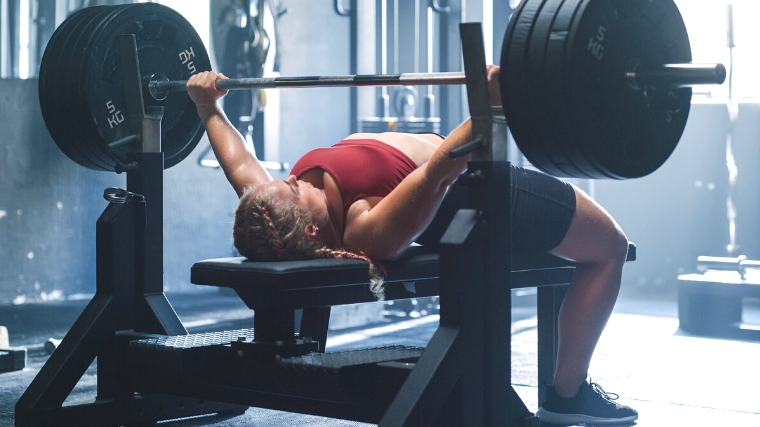
You’ll also find that a wider grip hits your chest a bit more, but may also come with the caveat of added strain on your shoulders. You’ll have to balance the scales for yourself and decide if a wider grip is appropriate.
Benefits of the Wide Grip
- Ideal for lifting the heaviest weights possible on the bench press.
- May increase chest activation and help you push through sticking points. (2)
- Places more torque on the shoulder joints than a moderate or close grip.
How to Use the Wide Grip
A good wide-grip bench isn’t as simple as grabbing the bar with your hands as far apart as humanly possible. Instead, start placing your middle or index fingers on the rungs, and experiment with additional width from there.
The wide-grip bench press will make it more difficult for you to tuck your elbows. You should also expect to make contact with your chest a bit higher up, depending on your limb lengths and technique.
If you’re a competitive powerlifter, your federation likely imposes restrictions on grip width. Refer to their technical rules before you change your bench press grip.
Neutral Grip
If you have access to the appropriate equipment, you can even bench press with a neutral grip, with your palms facing your midline. This requires a Swiss barbell that has several different handles running perpendicular to the shaft itself.

Should you have a Swiss bar in your commercial or home gym, you can use a neutral grip on the bench press to work around an injury or introduce some variety into your bench press training. Neutral-grip exercises are often quite comfortable and ergonomic, which also makes them great for beginners.
Benefits of the Neutral Grip
- Adds an element of novelty to your bench press training.
- May be more comfortable on your joints than other bench press grips.
- Easy to learn for beginners.
How to Use the Neutral Grip
Assuming you have access to a Swiss bar, the neutral grip is as simple as grabbing whichever handle is most comfortable for you. You should be able to maintain vertical alignment between your wrist and elbow the entire time.
Don’t be afraid to let the bar make chest contact low on the torso, and keep your elbows somewhat tucked. A good rule of thumb to use is to match the angle of your upper arm with the angle of the handle you’re gripping.
Reverse Grip
The reverse grip is one of the most unique ways to handle a barbell. It may look unusual, but in the right circumstances, the reverse grip is a seriously-valuable asset.

By flipping your hands around and grabbing the barbell with a supinated, palms-facing-behind you grip, you should find that the bench press becomes very smooth and comfortable for your shoulders. You just have to get past the initial learning curve.
Benefits of the Reverse Grip
- May reduce shoulder, elbow, or wrist discomfort from other bench press grips.
- Provides more upper chest (and even biceps brachii) activation than a pronated grip. (4)
- A great way to make lighter weights feel more challenging on the bench press.
How to Use the Reverse Grip
Getting the reverse-grip bench press down pat will take a bit of trial and error. You’ll want to begin with a close or moderate grip, and then experiment from there. Start by placing your ring or pinky fingers on the rungs with an underhand grip such that your palms point behind your head.
Note that the wider you grab the bar when using the reverse grip, the more awkward it will be to hold. A wide reverse-grip bench press may not sit perfectly in your hands. Consider using wrist wraps if you go wide here.
Once you’ve found a width that works for you, perform the bench press normally. Emphasize tucking your upper arm as you lower the bar.
Thumbless Grip
Traditionally, athletes perform the bench press with their thumbs wrapped around the shaft of the bar. This helps ensure that the barbell remains locked in place and often improves power output.
A thumbless grip (colloquially known as the “suicide grip”) is exactly what it sounds like. You may find that unwrapping your thumbs and aligning them with your forefingers helps you mentally connect with your chest — at a cost.
Using a thumbless grip substantially increases your risk of injury, as the barbell becomes liable to slip out of your palms. The thumbless grip is high-risk, and potentially high-reward.
Benefits of the Thumbless Grip
- May increase your mind-muscle connection with your pecs or triceps during the bench press.
- Can reduce strain on the wrists or elbows in some cases.
How to Do the Thumbless Grip
The thumbless grip is extremely straightforward. Assume your standard bench press grip width. Once you’ve removed the barbell from the hooks, unwrap your thumbs before beginning to lower it down to your chest. You should also allow your wrists to roll back a bit more. Maintain that position for the duration of your set — it is advisable to re-wrap your thumbs before placing the bar back into the rack.
You should also seriously consider using chalk to dry your palms if you work with a thumbless grip. A spotter can be helpful, but should the bar slip out of your hands, they likely won’t be able to intervene in time.
Bulldog Grip
If you’re looking for a more advanced grip technique, you might want to dabble with the bulldog grip. Named for its resemblance to a bulldog’s paw, the bulldog grip requires you to slightly twist your hand around the bar and place it as deep in your palm as possible.
In theory, this grip style could increase your strength on the bench press due to improved leverages. “Hooking” the bar deep into your palm places it directly over the radius bone, which could result in a more effective transfer of force.
Benefits of the Bulldog Grip
- Provides better vertical alignment between the barbell and your wrists.
- May increase the amount of weight you can lift on the bench press.
How to Do the Bulldog Grip
Assume your standard bench press grip. Then, slightly twist your hands such that your pinky finger and ring finger slide off the shaft a little and the bar rests deeper into the nook between your thumb and index finger.
This secures the barbell in place while you hold it deep into the meat of your palm, directly above the radius bone. From here, perform the bench press as you normally would. You might consider using wrist wraps when incorporating the bulldog grip for the first time, or practicing with very light weights until you get the hang of it.
How to Do the Bench Press
The perfect bench press grip is all well and good, but it won’t lift the weight for you. Once you’ve got your hand game down pat, you need to know how to bench press like a pro.
Bench Press Video Guide
If you’re a visual learner, check out this step-by-step guide from BarBend and multiple-time world-record holding powerlifter Taylor Atwood:
[Related: United States Powerlifting Association Dissolves Executive Committee In Wake of Controversy]
Step 1 — Set Yourself Up
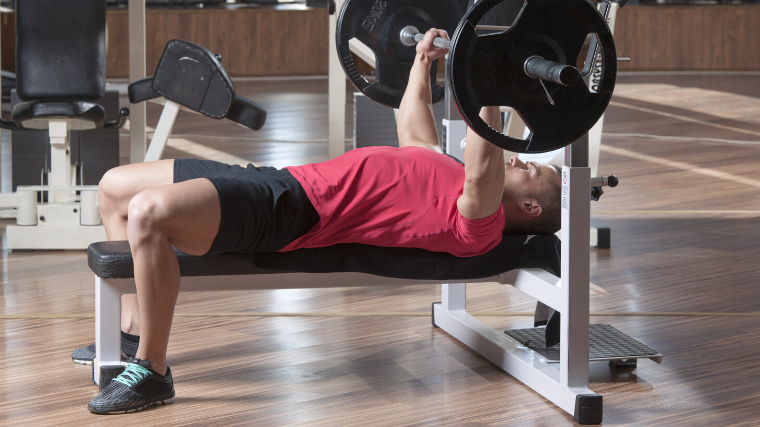
Lie down on the bench press such that the bar is directly above eye-level. Grip the bar with your grip of choice and plant your feet firmly on the floor. Your shoulder blades should be pinched back and down, and you should have a slight arch in your lower back.
Coach’s Tip: A good bench press arch takes time to develop, but will improve your leverage and safety during the movement.
Step 2 — Unrack the Bar
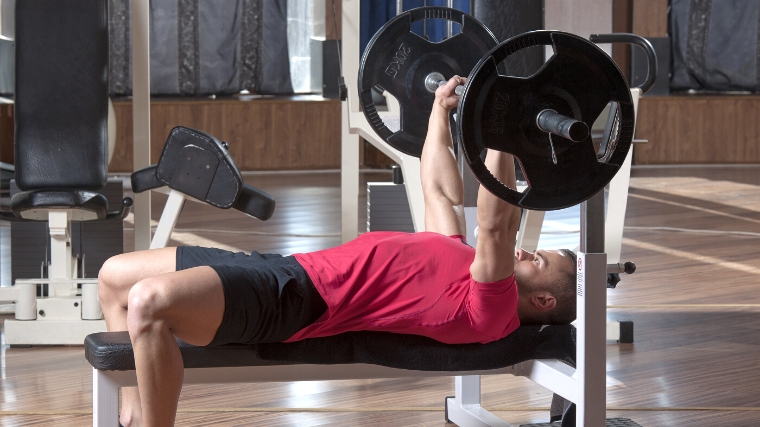
Once you’re set up, remove the barbell from the rack. Take a deep breath in to stabilize your core and “pull” the bar out of the rack horizontally. Stabilize the weight directly over your shoulders with your elbows locked.
Coach’s Tip: Avoid pressing the bar straight up out of the hooks, as this can inadvertently cause you to lose your shoulder pinch along the way.
Step 3 — Lower It Down
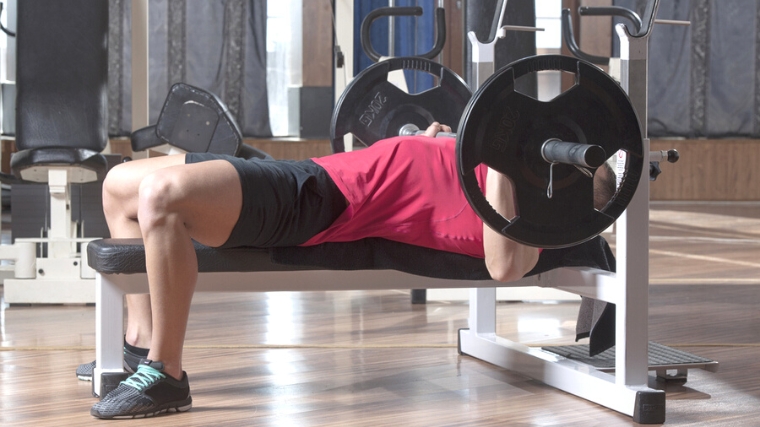
Release your first breath and inhale a new one. Then, slowly lower the weight down until it touches your chest (or as low as your mobility permits). The point of contact between the bar itself and your chest will depend on your grip width, just make sure that your forearms remain perpendicular to the bar the whole way down.
Your elbows should stay under the bar the entire time. Pause at the bottom of your range of motion for a brief moment.
Coach’s Tip: As the bar comes into contact with your chest, avoid “collapsing” your torso. Push your chest up into the bar to stay tight.
Step 4 — Press, Powerfully

[Read More: Our Favorite Forearm Workouts, + the Best Forearm Exercises]
Once the bar is motionless at the bottom, reverse the movement and press the bar up and back. The barbell should travel back towards your shoulder joints as you straighten your elbows. Forcefully exhale as the bar approaches arm’s length.
Coach’s Tip: Your bar path should have a mild arc to it. If you’re pressing in a vertical line, you’re losing out on some potential power.
Get a Grip
The bench press is about as close to weight room royalty as it gets. So, if you want to make it a cornerstone movement on your next chest day, you need to know how to grab onto the thing in the first place.
The right grip during the bench press can make all the difference in the world. Dabble in different grips until you find the one that suits your body and your goals, and then go to town.
More Training Content
References
- Barnett, Chris & Kippers, Vaughan & Turner, Peter. (1995). Effects of Variations of the Bench Press Exercise on the EMG Activity of Five Shoulder Muscles. The Journal of Strength & Conditioning Research. 9. 10.1519/00124278-199511000-00003.
- Larsen, S., Gomo, O., & van den Tillaar, R. (2021). A Biomechanical Analysis of Wide, Medium, and Narrow Grip Width Effects on Kinematics, Horizontal Kinetics, and Muscle Activity on the Sticking Region in Recreationally Trained Males During 1-RM Bench Pressing. Frontiers in sports and active living, 2, 637066.
- Saeterbakken, A. H., Stien, N., Pedersen, H., Solstad, T. E. J., Cumming, K. T., & Andersen, V. (2021). The Effect of Grip Width on Muscle Strength and Electromyographic Activity in Bench Press among Novice- and Resistance-Trained Men. International journal of environmental research and public health, 18(12), 6444.
- Lehman G. J. (2005). The influence of grip width and forearm pronation/supination on upper-body myoelectric activity during the flat bench press. Journal of strength and conditioning research, 19(3), 587–591.
Featured Image: Pavel L Photo and Video / Shutterstock
